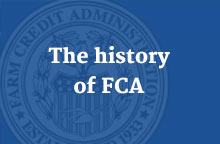
The cooperative way
All of the banks and direct-lending associations of the Farm Credit System are cooperatives.
Each institution is owned and controlled by the farmers who borrow from it. They control the institution by setting policies and helping make decisions. This keeps the institution committed to serving rural credit needs.
The System’s cooperative business model sets it apart from most other commercial lenders.
A cooperative since 1916
Congress set up the Farm Credit System in 1916 as a cooperative because it wanted to ensure that the System could fulfill its public mission of providing long-term and affordable credit services to agriculture and rural America.
The seven cooperative principles
Cooperatives around the world, including the Farm Credit System, follow the seven basic principles below. The roots of these principles can be traced back to Rochdale, England, where the first modern cooperative was founded in 1844.
- Voluntary and open membership. Cooperatives are voluntary organizations, open to all people able to use their services and willing to accept the responsibilities of membership, without gender, social, racial, political, or religious discrimination.
- Democratic member control. Cooperatives are democratic organizations controlled by their members — those who buy the goods or use the services of the cooperative. The members participate in setting policies and making decisions.
- Members’ economic participation. Members contribute equally to, and democratically control, the capital of the cooperative. This benefits members according to the amount of business they conduct with the cooperative rather than the amount of money they invest in it.
- Autonomy and independence. Cooperatives are autonomous, self-help organizations controlled by their members. If a co-op enters into agreements with other organizations or raises capital from external sources, it does so based on terms that ensure democratic control by its members and the autonomy of the cooperative.
- Education, training, and information. Cooperatives provide education and training for members, elected representatives, managers, and employees so they can contribute effectively to the development of their cooperatives. Members also inform the general public about the nature and benefits of cooperatives.
- Cooperation among cooperatives. Cooperatives serve their members most effectively and strengthen the cooperative movement by working together through local, regional, national, and international structures.
- Concern for community. While focusing on member needs, cooperatives work for the sustainable development of communities through policies and programs accepted by the members.
The System’s core cooperative principles
In 2005, the Farm Credit Administration conducted a study to identify and better understand the range of cooperative practices employed by System institutions. The study found that, like most other cooperative organizations, FCS institutions generally adhere to three core cooperative principles: user-ownership, user-control, and user-benefits. These principles are the underlying foundation for the System’s cooperative practices.
FCA’s commitment to the system’s cooperative structure
On October 14, 2010, the FCA board adopted a resolution and a policy statement reaffirming its support for, and commitment to, these core principles as part of the cooperative business model of the Farm Credit System.



